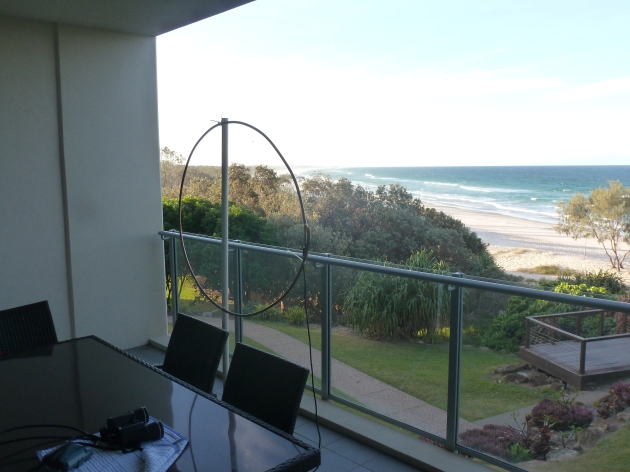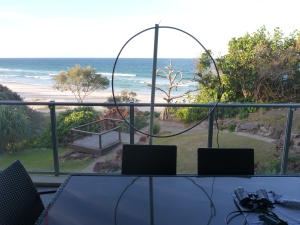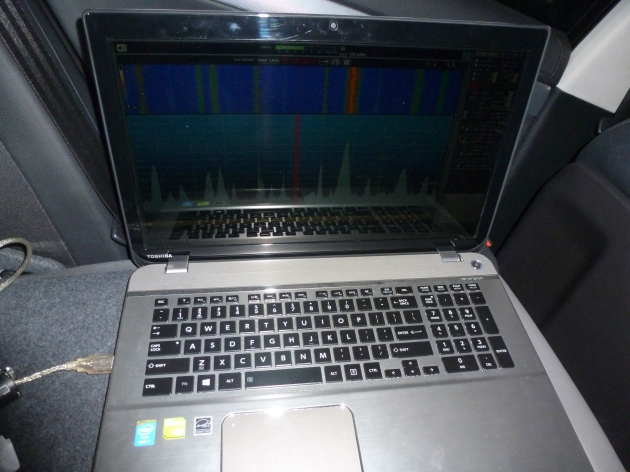Have loop, will travel: out in the field with a $20 FM antenna
August 17, 2014
It’s not much fun going to the trouble of building any antenna without taking it out for a play, right?
The FM loop antenna may offer satisfactory reception whilst travelling on vacation (above) or on a field trip. Under these situations, a small FM yagi antenna may be considered too obtrusive or unwieldy. The loop offers a compromise. Surely, that is an incentive to get out the city into some fresh air!
Example #1: Beachfront resort
On the small balcony of a 2nd floor beachside apartment, permanent tropospheric scatter reception from 80 kW public services northwest was possible at 354 km / 220 mi with this loop antenna.
‘Dead of winter’ conditions prevailed, which were typical for mid July. However, these signals were comfortably audible (e.g. strong enough to trigger Yamaha’s CSL) over five consecutive nights.
Fading occurred only very briefly. The maximum elevation on the balcony was 22 m / 72 ft ASL.
A component FM tuner was used at this apartment with the loop.
Example #2: D’aguilar Range portable field trip
At a secluded spot on the D’aguilar Range, the loop was mounted in the carpark on a three metre PVC mast. The circular antenna can be accommodated in a sedan by collapsing the rear seat.
Upon arrival on-site, the loop took less than five minutes to erect by moonlight (if one is lucky!) or torchlight. OK, so she ‘looks a bit worse for wear’ on this occasion, but nonetheless performs!
At this location, the lowest figures from the altimeter (taken between 10-10:30 pm) indicated an elevation of 468 m / 1,535 ft ASL with a warm ambient temperature of 10.8 degrees C / 51 F.

Mt Samson © 2013 Berknot
The spot was located between the SOTA (Summits On The Air) mountains of Sim Jue and Samson.
The date of the trip was early August at 10:30 pm. Despite a very congested FM dial, the following services listed below were heard in flat conditions with a tropospheric index of nil. These stations are never heard permanently at home during winter, apart from some of the northern reception. An obstructed southern path (which includes the McPherson range topping 1,359 m /4,459 ft ASL) may be the likely explanation.
North
- 3 kW commercial services at 274 km / 170 mi
- 1 kW commercial service at 217 km / 135 mi
West
- 2 kW community service at 145 km / 90 mi
South West
- 100 kW commercial service at 416 km / 258 mi
South
- 15 kW commercial services at 331 km / 206 mi
- 1 kW community service at 272 km / 169 mi
- 100 watt commercial services at 169 km / 105 mi
- 50 watt public translator at 163 km / 101 mi
A brief check with the car radio indicated that the majority of these stations were not audible with the car radio antennae. This suggests that the loop was performing as it should. In fact, one of the 5 kW commercial services located 77 km / 48 mi south was audible as an image on the receiver. Simply, there were no obstructions in the site’s path.
Live in the city? A field trip can be rewarding fun with any tuner or antenna!
JamesMP has some taken some interesting photos of the aforementioned Dundas mountainous region. Previously, reception at this region has been discussed in this series.
Example #3: Beachfront apartments
These photographs illustrate the ease of assembling the FM loop antenna at two contrasting beachside apartment complexes, located just 900 m / 0.6 mi apart.
On the balcony of a 14nd floor beachside apartment, permanent tropospheric scatter reception from 80 kW public services northwest was possible at 578 km / 359 mi with this loop antenna in mid October. Signals were audible every evening during the stay. The maximum elevation on the balcony was estimated to be 60 m / 197 ft ASL.
Contrast the observations directly above to those in a complex above a popular entertainment precinct! On this particular 15nd floor balcony, all modes of long distance FM reception were affected by enormous levels of electrical interference. In addition, dozens of high rise apartment towers in close proximity attenuated signals. These observations may reflect a worst-case scenario.
Despite this apartment building being a ‘shocker’ of a location, FM signals received with the loop were more distant than results using the vertical telescopic antenna on the Silabs’ portable receiver. (The portable receiver exhibited images across the FM band. This symptom ‘masked’ weak signals, of course).
At this location, the antenna could not be left outside overnight or positioned at the top of the PVC mast, both of which are normally undertaken. Why not? The antenna was readily visible from neighbouring balconies and possibly from the busy tourist strip below.
The maximum distance at this location was 402 km / 250 mi from 100 kW public services. This reception was only possible during enhanced conditions; those stations were not permanently receivable each night. The antenna was moved inside the apartment after 9 pm nightly which may have limited opportunities for more distant signals.
Distances & azimuths of FM broadcasts are calculated with FM Scan. Station logos are solely provided for the purposes of research & education under the Fair Use provisions of the Copyright Act in this jurisdiction. This article will be continuously updated, it is a work in progress.































